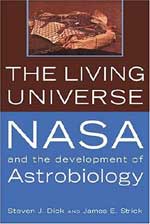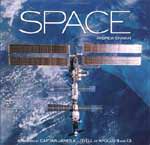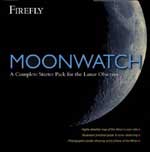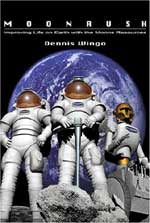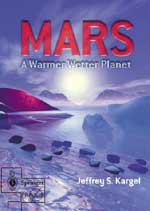
This book is an in-depth, technically precise narrative on the geology of Mars. The wealth of provided satellite imagery makes it easily understood by the layman. Images mostly come from Mars Global Surveyor’s MOC system and the Mars Odyssey THEMIS system. Comparisons to the author’s own photographs of Earth’s geological magic magnify the similarities. Yet this is not a picture book. Rather, Kargel does a magnificent job of tying the features into appropriate geological processes. For example, size, frequency and quantity of craters indicate age and tectonics. Crater rim condition demonstrates weathering. Alluvial fans, valleys, and moraines indicate fluid flow. All together these and others lead Kargel to believe and to show us that, at times, the surface of Mars must have had significant amounts of liquid flowing and pooling on its surface. That is, Mars was a much wetter planet than it is today.
But where has this liquid come from and gone to? We don’t know for sure, but Kargel believes the liquid was and still is present on Mars. Warmer equatorial regions have liquid frozen at great depth; mid-latitude regions have this material close to or at the surface; while the polar ice caps and their glaciers act as high density fluid moving at an amazingly slow pace. Kargel’s supposition is that Mars began with a comparatively homogeneous mantle but transitions occurred via ‘MEGAOUTFLO’ events. These episodes of internal geologic activity, such as volcanism, together with cycles of changing orbital eccentricity and obliquity, led to climatic oscillations. Hence, he concludes that though today Mars is very dry, it must have been, at least once before, both a warmer and wetter planet.
The shear breadth of this book can be daunting. Rock types and their personalities abound. Chemical compounds, their formations and their significance also get a solid billing. This is not surprising as after all, Kargel is a pre-eminent geologist and the forward by Harrison Schmitt leaves no doubt whatsoever about the subject. Topics within the text include active outgassing of juvenile volatiles from the mantle, glaciers that flow like condensed laminar fluid down an inclined plane and the forming of the mineral jarosite which requires many times its mass of water.
However this book is not a dry technical treatise. Kargel uses everyday language to discuss what is seen on Mars today, why it came to be, and what use can be made of this new knowledge. He considers the views of Cydonia Clanists and Percival Lowell and how unique life may exist on Mars and where it may be hiding. A very high level view presents the planet’s life cycle starting with accretion and concluding with the charring of its surface during our sun’s final explosion and subsequent collapse into a white dwarf star. He also discusses optimal landing locations for explorers and colonists of Mars, together with processes and techniques for power generation, water provisioning and infrastructure build-out. Still, the focus of this book is Mars’ surface geology and the deductions that result.
And in keeping with the progress of scientific investigation, Kargel is quick to point out that much is needed before any scientific advance is considered valid. This must be kept in mind throughout the book as the phraseology continually changes between observed fact and speculation. Also, given the complexity of the subject, the breadth of discussion is perhaps too broad. This is reminiscent of a wedding guest who waxes too eloquently when they get in front of the microphone. Still, for those who want to know what those amazing pictures of Mars are telling us, this is an excellent book.
Further, just as the proof of this book was nearing completion, the two Martian probes Opportunity and Spirit landed. Some of their early images appear but certainly much is left out. However, the book focuses on planet wide issues as seen through expansive satellite views so the probes’ information would likely be complementary to rather than a replacement of the supposition.
Some people say that we already know that Mars has a lot of rocks on it so why do we keep sending probes to see more rocks? Well a diamond on a wedding band can equally be considered just a rock and isn’t of great value, only don’t tell that to the wearer. Each picture of Martian rocks is much more than just another picture. Jeffrey Kargel in his book Mars: A Warmer Wetter Planet, provides us with the information and background to interpret the pictures and be thankful for their provision. Then, by placing these images into a geologic context, he gives a whole lot of understanding of the planet Mars and its rock formations.
Read more reviews, or order a copy online from Amazon.com.
Review by Mark Mortimer

